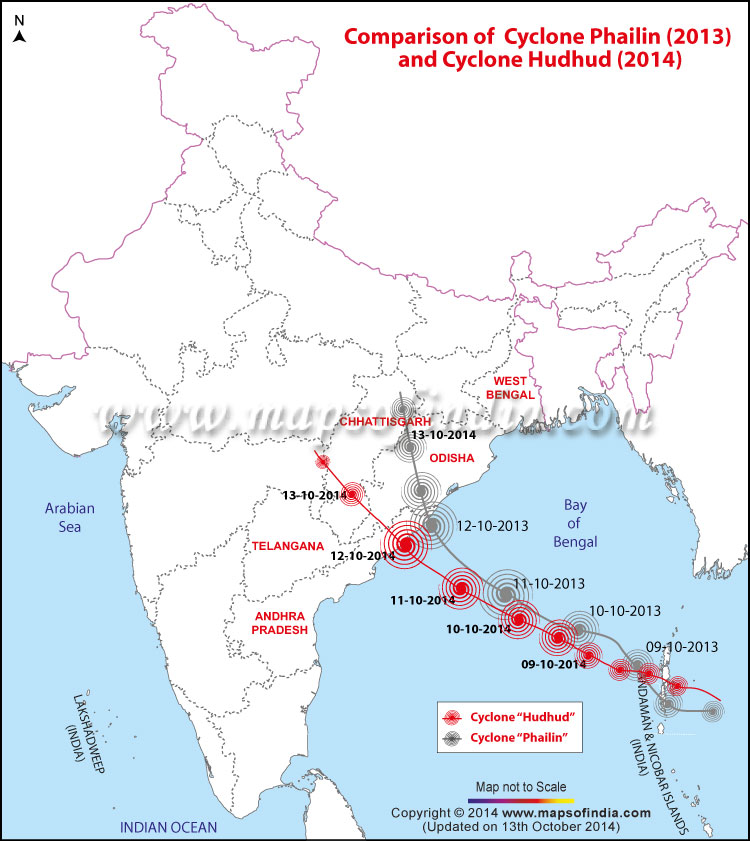Comparison of Cyclone Phailin 2013 and Cyclone HudHud 2014 |

* Map showing Comparison of Cyclone Phailin 2013 and Cyclone HudHud 2014 , their path, route, date, intensity, etc.
|
Cyclone Phailin |
Cyclone Hudhud |
|
|
Origins |
On October 4, 2013, a tropical depression was noted in the Gulf of Thailand, around 450 km west of Vietnam’s Ho Chi Minh City. This system moved westwards over the next few days, and emerged into the Andaman Sea by October 7. By October 9, the India Meteorological Department (IMD) noted that it had turned into a deep depression and was consolidating. When the system moved into the Bay of Bengal, it rapidly reorganised along the edge of a high pressure subtropical ridge.It had now intensified into a cyclonic storm, the IMD reported. It was named Cyclone Phailin. | On October 6, 2014, a low pressure area was created above the Andaman Sea because of an upper air cyclonic circulation. By the next day, the IMD upgraded it to a depression. The US Joint Typhoon Warning Center issued an alert for tropical cyclone formation. The IMD now classified it as a deep depression. On October 8, it made a landfall over an island in the Andaman and its intensity was enough for IMD to classify it as a cyclonic storm, Hudhud. After Cyclone Hudhud entered the Bay of Bengal, it intensified and was accordingly upgraded to a severe cyclonic storm. On October 10, the IMD upgraded it further to a very severe cyclonic storm. |
| Nomenclature | Phailin means sapphire in Thai. Following the procedure of naming such cyclones over this part of Indian Ocean, it was Thailand’s turn to suggest a name from the list of assigned names. | The name Hudhud was given by Oman, according to the procedure, and in Arabic it refers to the Hoopoe bird. |
| Wind speeds | The storm system’s peak intensity was wind speeds of 260 kmph. | Its peak strength was officially recorded to be 175 kmph wind speeds. |
| Landfall | Cyclone Phailin made landfall near Gopalpur in Odisha state at about 9.15 pm local time on October 12, 2013. | Cyclone Hudhud made landfall close to Pudimadaka, around 50 km from the major port city Visakhapatnam in Andhra Pradesh at around 11.30 am on October 12, 2014, exactly one year after Cyclone Phailin hit the Odisha coast. |
| Loss of lives and property | Cyclone Phailin blew away the power supply, uprooted thousands of trees, flung trucks and other vehicles like toys and crushed thousands of buildings in districts like Ganjam. Heavy rains that followed the cyclone caused massive flooding in northern Odisha’s Balasore and Mayurbhanj districts. As many as 12 million people in 17 districts were affected by the double whammy of the cyclone and floods. The total death toll, according to conservative estimates, was 44. The most destructive storm to hit India after the devastating super cyclone of 1999, Cyclone Phailin caused an estimated loss of $4 billion to crops.Around 1.1 million people were evacuated in Odisha and about 130,000 in Andhra Pradesh. | The death toll from Cyclone Hudhud stood at 24 on October 14. The bustling city of Visakhapatnam was badly hit. The city’s airport was shut down for repairs, its roof blown away by the storm. Electricity in the city was down two days after the storm. Rail operations continued to remain suspended after 48 hours. Overall, 500,000 people were forced to leave their homes in Andhra Pradesh, and some 160,000 in Odisha. Big crop damages were reported from coastal Andhra areas. In Odisha, flooding was the state’s biggest worry. Besides Visakhapatnam, the coastal districts of Srikakulam, East Godavari and Vizianagaram were the worst hit in Andhra Pradesh. In Odisha, Koraput, Gajapati, Malkangiri and Rayagada are among the most badly affected districts. An estimated 80,000 homes in Odisha were damaged. |
Source: Media reports
WBSKA14102014
EBVD
Explore More:
Cyclone Roanu
Cyclone Ashobaa
Cyclone Nilofar
Cyclone Phailin
Cyclone HudHud
Cyclone Prone Areas in India
SMS-Based Cyclone Warning System Launched in India